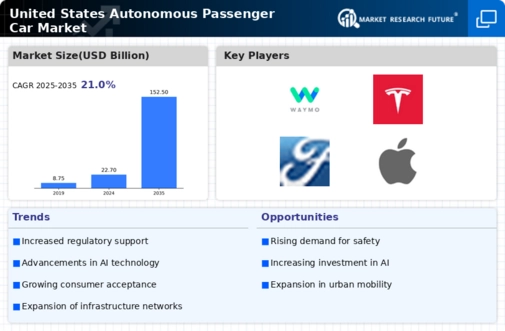Regulatory Support
Regulatory frameworks play a crucial role in shaping the Global United States Autonomous Passenger Car Market Industry. Governments are increasingly recognizing the potential benefits of autonomous vehicles, leading to the establishment of supportive policies and regulations. For example, states like California and Arizona have implemented favorable legislation to facilitate testing and deployment of autonomous vehicles. This regulatory support not only fosters innovation but also instills consumer confidence in the safety and reliability of autonomous technologies. As regulations evolve, they are expected to create a conducive environment for market growth, potentially contributing to the market's expansion to 150.25 USD Billion by 2035.
Environmental Concerns
Environmental sustainability is becoming increasingly paramount, influencing the Global United States Autonomous Passenger Car Market Industry. As concerns about climate change and air pollution rise, consumers and policymakers are advocating for cleaner transportation solutions. Autonomous vehicles, particularly those powered by electric or hybrid technologies, align with these environmental goals. The shift towards sustainable mobility is likely to drive investment and innovation in the sector, as manufacturers seek to develop eco-friendly autonomous solutions. This trend may contribute to the market's anticipated growth, as consumers gravitate towards vehicles that not only offer convenience but also minimize their environmental footprint.
Market Growth Projections
The Global United States Autonomous Passenger Car Market Industry is poised for substantial growth, with projections indicating a market value of 150.25 USD Billion by 2035. This anticipated growth reflects a compound annual growth rate of 11.43% from 2025 to 2035, driven by various factors including technological advancements, regulatory support, and changing consumer preferences. The market's expansion is indicative of a broader shift towards autonomous mobility solutions, which are expected to redefine transportation paradigms. As investments in research and development increase, the industry is likely to witness innovations that further enhance the capabilities and appeal of autonomous vehicles.
Consumer Demand for Safety
There is a growing consumer demand for enhanced safety features in vehicles, which significantly influences the Global United States Autonomous Passenger Car Market Industry. Autonomous vehicles are perceived to offer superior safety compared to traditional cars, as they are equipped with advanced driver-assistance systems that reduce human error. This shift in consumer preference is likely to drive adoption rates, as more individuals seek vehicles that promise improved safety outcomes. The market's growth is expected to reflect this demand, with projections indicating a compound annual growth rate of 11.43% from 2025 to 2035, underscoring the importance of safety in shaping consumer choices.
Technological Advancements
The Global United States Autonomous Passenger Car Market Industry is experiencing rapid technological advancements, particularly in artificial intelligence and machine learning. These innovations enhance vehicle perception, decision-making, and navigation capabilities. For instance, companies are integrating advanced sensor technologies, such as LiDAR and radar, which significantly improve safety and efficiency. As these technologies mature, they are expected to drive consumer acceptance and adoption rates. The market is projected to reach 45.67 USD Billion in 2024, indicating a robust growth trajectory fueled by these advancements. The continuous evolution of technology is likely to redefine mobility and reshape urban transportation landscapes.
Urbanization and Mobility Challenges
Rapid urbanization presents significant mobility challenges, thereby impacting the Global United States Autonomous Passenger Car Market Industry. As urban populations swell, traffic congestion and inadequate transportation infrastructure become pressing issues. Autonomous vehicles offer potential solutions by optimizing traffic flow and reducing the number of vehicles on the road. This capability is particularly appealing to urban planners and policymakers seeking to alleviate congestion. The increasing need for efficient urban mobility solutions is likely to drive the adoption of autonomous vehicles, as they promise to enhance transportation efficiency and improve overall urban living conditions.




